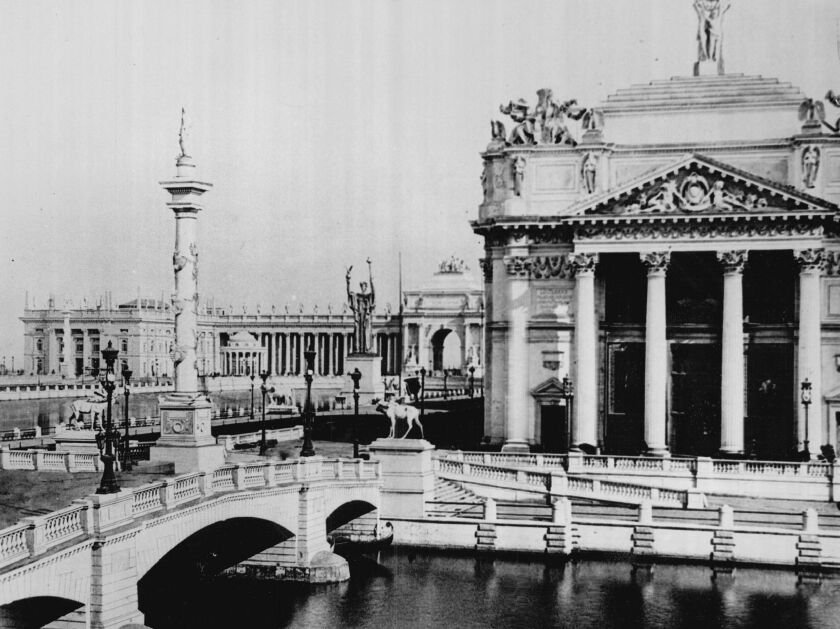Sometimes the obvious sit in plain sight, unnoticed, until someone points it out.
Despite a lifetime of eating hot dogs, a connection eluded me until I attended Northwestern literature professor Bill Savage’s lecture about ketchup during the Chicago History Museum’s Hot Dog Fest three years ago and he casually dropped the bomb.
“Two immigrant brothers came here and in 1893, at the World’s Fair, had the brilliant idea to put a viener, a Viennese sausage, in a bun, and voila, the hot dog is born, or at least the Vienna Beef hot dog is born.”
Ohhh, Vienna led to wiener just as Frankfurt led to frankfurter. Makes sense.
OPINION
With the 125th anniversary of the opening of the World’s Columbian Exposition May 1, expect fond visits to Chicago’s debut in the global spotlight. The fair’s impact stays with us, in the many products debuted: from Vienna Beef to Aunt Jemima pancakes, from the Ferris wheel to the zipper. The blue ribbon that Pabst beer boasts of on every can was awarded at the 1893 fair.
Wait a sec. Aunt Jemima Pancakes … hmm … maybe we better skip that one. Awkward. Uncomfortable.
Besides, the product had really debuted a few years earlier. The creators of Aunt Jemima went bankrupt in 1890, and a second company relaunched the brand at the fair, hiring a South side cook and former slave named Nancy Green to wear an apron and kerchief and dole out pancakes.
Too late to turn back now. Anyway, speaking of impact that lingers, Aunt Jemima, and the uncomfortable racial stereotypes clustered around her can do more than ballyhoo pancakes. She also welcomes us to consider an aspect of the fair that, while not as eagerly appreciated as hot dogs or beer, is just as current and far more important.
In 1890, when the Chicago fair was first being planned, black Americans tried be included in the great exposition — to see their achievements highlighted and celebrated. The Civil War had been over for 25 years. They were citizens now. They had legal rights, supposedly.
Their effort failed, entirely. No members of the fair committee formed by President Benjamin Harrison were black. There was a representative from Alaska, but when African-American groups officially complained, the president responded that there was just no room.
“The embarrassment of being ignored by the White House was almost matched by the embarrassment of begging for what Negroes regarded as their right of representation,” one historian noted.
Blacks couldn’t even get jobs as guards at the fair. They would try, and be turned away. Of the 65,000 displays and exhibits at the fair, none highlighted the achievements of an African-American.
Not that they were excluded entirely. White organizers brought in villagers from Western Africa and set them up in a thatched enclosure.
“As if to shame the Negro,” Frederick Douglass wrote, “the Dahomians are also here to exhibit the Negro as a repulsive savage.”
Douglass contributed to a cri di coeur issued by Ida B. Wells. Fresh from a speaking tour of England, she wasn’t about to yield the fair to Nancy Green and her pancakes and happy tales of plantation life. Wells printed 20,000 copies of an 80-page booklet titled, “THE REASON WHY the Colored American is not Included in the World’s Columbian Exposition” and had them distributed to fairgoers.
The preface states:
“At Jackson Park are displayed exhibits of [America’s] natural resources, and her progress in the arts and sciences, but that which would best illustrate her moral grandeur has been ignored. The exhibit of the progress made by a race in 25 years for freedom as against 250 years of slavery, would have been the greatest tribute to the greatness and progressiveness of American institutions which could have been shown the world.”
Casting a wide net, the preface was also written in French and German.
Much of the pamphlet was taken up with lynching, which would peak in 1894. Douglass’ introduction, if you substitute execution by skittish cops for lynching, could have been written yesterday.
“No proof of guilt is required,” he wrote. “It is enough to accuse, to condemn and punish the accused with death.”
The pamphlet laid out heartbreaking documentation of black achievement in the arts and sciences, including lists of patents, who could have had a place at the fair, if only society allowed such a thing.
It would be a double irony if today we looked back warmly at this fair as a high water mark and ignored, once again, the lives of those who were excluded.
Sometimes the obvious sit in plain sight unnoticed until someone points it out.






